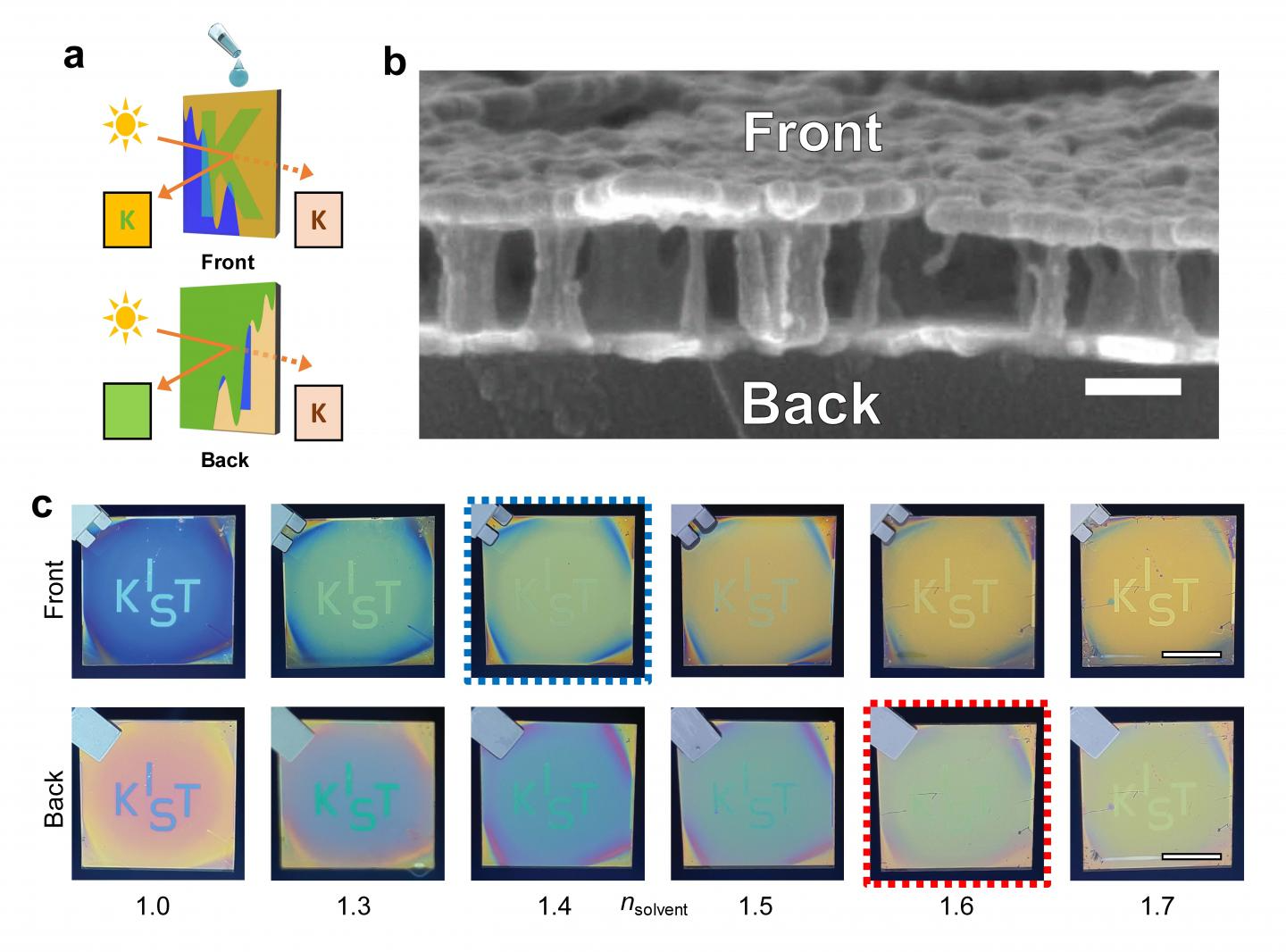Oct 21 2020
Advanced optics has investigated a range of nanoscale materials and their localization as they pave the way for novel optical outcomes. h
 (a) Conceptual illustration of direction-sensitive asymmetric optical camouflage by tunable optical Janus effect. (b) SEM images of the nanostructured Au film and CYTOP nanopillars. Scale bars, 200 nm. (c) Photographs of solvent-immersed etalon demonstrating asymmetric message hiding seen from the frontside (upper) and backside (lower) under media of n = 1.0 (air), nsolvent = 1.3, 1.4, 1.5, 1.6, and 1.7 (solvents). Scale bars, 1 cm. Image Credit: Taehyun Kim, Eui-Sang Yu, Young-Gyu Bae, Jongsu Lee, In Soo Kim, Seok Chung, Seung-Yeol Lee, and Yong-Sang Ryu.
(a) Conceptual illustration of direction-sensitive asymmetric optical camouflage by tunable optical Janus effect. (b) SEM images of the nanostructured Au film and CYTOP nanopillars. Scale bars, 200 nm. (c) Photographs of solvent-immersed etalon demonstrating asymmetric message hiding seen from the frontside (upper) and backside (lower) under media of n = 1.0 (air), nsolvent = 1.3, 1.4, 1.5, 1.6, and 1.7 (solvents). Scale bars, 1 cm. Image Credit: Taehyun Kim, Eui-Sang Yu, Young-Gyu Bae, Jongsu Lee, In Soo Kim, Seok Chung, Seung-Yeol Lee, and Yong-Sang Ryu.
The use of the optical Janus effect to view direction-sensitive data display has drawn huge attention due to its dynamic operation scheme, which provides discriminative information delivery. But the combination of nanomaterials in multiple layers restricts their application in dynamic and real-time color tuning.
A new study published in the Light Science & Applications journal by a research team under the guidance of senior researcher Yong-Sang Ryu (Sensor System Research Center, Korea Institute of Science and Technology, Republic of Korea) and Professor Seung-Yeol Lee (School of Electronics Engineering, Kyungpook National University, Republic of Korea) and collaborators reports a new liquid-permeable translucent mirror to realize asymmetric reflective color contrast based on the viewing direction.
By using simple and economical metal-dielectric-metal (MDM) films, the researchers developed an optical device that can display distinct colors and messages based on the viewing directions.
This optical device includes nanoscale air voids in the dielectric film space, which plays a crucial role in color tuning through infiltration of exposed liquids into the optical hotspots.
Since the dielectric films’ physicochemical properties guide color creations in visible ranges, depending on the in-depth insights into the optical phenomena based on the constituent nanostructures of MDM films, reflective color tuning in the differing refractive index of surrounding solvents was achieved. The researchers have outlined the optical properties of their devices.
We describe the design of a transreflective etalon that produces directionally asymmetric reflective colour depending on the direction of incident light. And we discovered that the precise control of the physicochemical properties of the comprising films led to creation of viewing-direction sensitive asymmetric information encryption varying both of nanostructures and surrounding liquids.
Study Researchers
“These results suggest that the manipulation of film geometries enables not only to display the colour contrast but to hide viewing-direction-sensitive message encryption via optical camouflage phenomenon,” the team added.
Moving forward, bidirectional display of two different tuneable messages/images appear to be a tangible goal in the next step to allow for a wider range of photonic applications, including dynamic/informative colour filters, smart windows, optical switches, double-side colour displays, optical data storage devices, and anti-counterfeiting devices.
Study Researchers
“Furthermore, as the proposed fabrication process is compatible with large-area substrates, the design can be applied to optical-sensing platforms,” the researchers predict.
Journal Reference:
Kim, T., et al. (2020) Asymmetric optical camouflage: tuneable reflective colour accompanied by the optical Janus effect. Light: Science & Applications. doi.org/10.1038/s41377-020-00413-5.